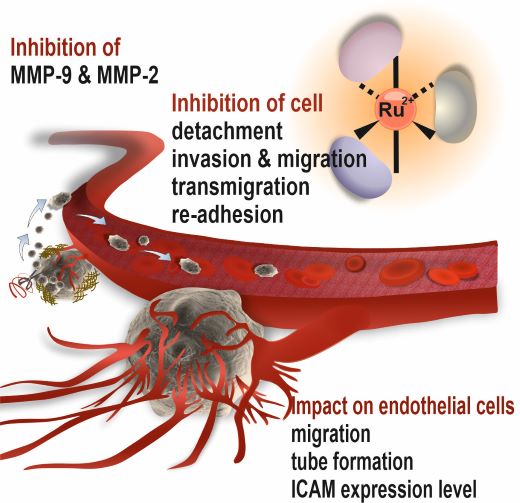More than 90% of cancer deaths are estimated to be associated with metastases. To adapt anticancer therapy to this phenomenon, in addition to cytotoxic properties, the compound should inhibit metastasis formation at many stages of the process.
than 90% of cancer deaths are estimated to be associated with metastases. To adapt anticancer therapy to this phenomenon, in addition to cytotoxic properties, the compound should inhibit metastasis formation at many stages of the process.
The main goal of our work is to test ruthenium complexes using various in vitro functional assays to provide information on the tested compounds' effect on cancer cells' ability to detach, migrate, invade, survive, or adhere. In addition to functional tests, molecular assays based on various markers are used to understand the molecular mechanism of activity and to identify potential targets for the tested compounds.
In cooperation with Prof. Philippe Gros and Prof. Franck Suzenet, we have designed a series of Ru polypyridyl complexes, and some of which had a pronounced impact on cancer cell detachment, migration, and adhesion as well as on endothelial cell angiogenesis (OPUS 11).
- I. Gurgul, E. Janczy-Cempa, O. Mazuryk, M. Lekka, M. Łomzik, F. Suzenet, P. C. Gros, M. Brindell “Inhibition of Metastasis by Polypyridyl Ru(II) Complexes through Modification of Cancer Cell Adhesion – In Vitro Functional and Molecular Studies” J. Med. Chem. 2022, 65, 10459-10470.
- I. Gurgul, O. Mazuryk, K. Stachyra, R. Olszanecki, M. Lekka, M. Łomzik, F. Suzenet, P. C. Gros, M. Brindell “Impact of Polypyridyl Ru Complexes on Angiogenesis - Contribution to Their Antimetastatic Activity” Int. J. Mol. Sci. 2022, 23, 7708.
- O. Mazuryk, F. Suzenet, C. Kieda, M. Brindell “Biological effect of nitroimidazole derivative of polypyridyl ruthenium complex on cancer and endothelial cells.” Metallomics 2015, 7, 553-566.
In cooperation with Dr M. Ganeshpandian (NAWA Indo-Polish project) we have tested ruthenium organometallic compounds as potential cytotoxic and antimetastatic agents.
- C. Sumithaa, T. Manjunathan, O. Mazuryk, S. Peters, R. S. Pillai, M. Brindell, P. Gopinath, M. Ganeshpandian “Nanoencapsulation of Ru(p‑Cymene) Complexes Bearing Ginger-Based Natural Product into Liposomal Nanoformulation to Improve Its Cellular Uptake and Antiproliferative Activity” ACS Appl. Bio Mater. 2022, 5, 3241-3256
The application of Ru polypyridyl complexes as potential photosensitizers in photodynamic therapy (PDT) is evaluated considering hypoxic conditions as well as light-induced enhancement of antimetastatic activity.
- O. Mazuryk, E. Janczy-Cempa, J. Łagosz, D. Rutkowska-Żbik, A. Machnicka, A. Krasowska, P. Pietrzyk, G. Stochel, M. Brindell “Relevance of the electron transfer pathway in photodynamic activity of Ru(II) polypyridyl complexes containing 4,7-diphenyl-1,10-phenanthroline ligands under normoxic and hypoxic conditions” Dalton Trans. 2022, 51, 1888-1900.
- I. Gurgul, O. Mazuryk, D. Rutkowska-Żbik, M. Łomzik, A. Krasowska, P. Pietrzyk, G. Stochel, M. Brindell “Microwave-assisted synthesis and photodynamic activity of tris-heteroleptic Ru(II) complexes with asymmetric polypyridyl ligands” Polyhedron 2022, 225,116049.
